The dangers of overtaking another vehicle on a single carriageway are significant as it usually requires driving on the path of oncoming vehicles.
The overtaking manoeuvre increases the likelihood of a head-on collision where the combination of both the vehicles speed can often result in fatal consequences. Signs and road markings provide visual overtaking rules (see road markings) and often aid motorists by warning that bends in the road are ahead, or that there are dips in the road.
Usually however, it’s down to a drivers own judgement for when it is safe to overtake.
This overtaking tutorial is for both qualified drivers who wish to increase their knowledge and safe overtaking practices, and for learner drivers who may need to use the overtaking manoeuvre during the practical driving test. One or more of these overtaking situations is likely to occur during the practical driving test:
- overtaking a moving vehicle on the right (offside)
- overtaking parked cars
- overtaking cyclists
- overtaking on the left (undertaking on the nearside)
The main overtaking rule above all else is common sense. To only overtake if you are absolutely certain that the manoeuvre can be completed safely, and without causing risk or inconvenience to other road users. Before initiating the overtaking manoeuvre, ask yourself these questions:
- Is it legal to overtake?
Assess whether it is legal to overtake by locating no overtaking signs (see below) or continuous/solid white lines. See double white lines for further information. - Is it safe to overtake?
Ensure there are no bends in the road ahead or dips or hills and these will obscure oncoming traffic. Left and right junction up ahead can be hazardous as vehicles may emerge into the overtaking lane. - Is it necessary to overtake?
First decide whether it is necessary to overtake. If the vehicle in front is traveling close to the speed limit, there will be little to gain from overtaking. Are there queues of traffic ahead or a dual carriageway that will render the overtaking manoeuvre pointless? Assess also if it’s worth taking the risk as driving only a few miles per hour faster will often only result in a few minutes of time saved.
How to overtake a car
Although road and weather conditions vary, the same procedure should be applied for how to overtake a car. We shall take the role of the yellow car in the diagrams attempting to overtake the red car. This overtaking routine should be applied whether during a driving test or during general driving. Once you have established that it is legal, safe and necessary, you should apply the following overtaking routine:

Note:
- Blue shaded area
The blue shaded area indicates the blind spot that cannot be seen by viewing the mirrors. See blind spot for further information. - Signalling back into lane
It’s not always necessary or required to signal to the left when moving back into lane. If you feel that by signalling to the left may benefit another other road user however, feel free to do so.
Carry out the following routine for overtaking another vehicle
-
1. Mirrors
Check the interior mirror followed by the right side mirror to assess traffic to the rear and ensure no vehicles are overtaking your vehicle. A quick look over the right shoulder may be necessary to ensure no vehicles are hidden in the blind spot.
-
2. Position
Position your car just to the left centre line and not too close to the vehicle you intend on overtaking. This will give you the best possible view of the road ahead.
-
3. Speed
Match your cars speed to that of the vehicle you intend on overtaking. You may need to change down a gear to increase acceleration whilst overtaking.
-
4. Look
Look well ahead to ensure it is safe to overtake, that there are no oncoming vehicles, bends, dips, hills and that you have a gap to pull back into on the left.
-
5. Mirrors
If all looks safe ahead, take a final look into the mirrors to ensure no vehicles are overtaking you.
-
6. Signal
You must always signal to the right when overtaking to allow other motorists to acknowledge your intentions.
-
7. Manoeuvre
Pull out onto the opposite side of the road smoothly, accelerate briskly passed the vehicle you are overtaking, keeping a good safe distance from their side.
-
8. Speed
It’s important to accelerate briskly but safely to reduce the time spent on the opposite carriageway. Ensure you do not exceed the speed limit however.
-
9. Mirrors
When you have passed the vehicle you are overtaking, check the interior main mirror followed by the left side mirror to locate the vehicle you have overtaken. When the front of the vehicle you have overtaken appears in the main interior mirror, take this as a safe distance to pull back into the left lane.
-
10. Look
If for whatever reason you are unsure about where the vehicle is that you have overtaken or are attempting to overtake, look quickly over your left shoulder into the blind spot to ensure the vehicle is not hidden from your mirrors viewing angle.
Illegal overtaking
Illegal overtaking is an easy way to not only fail a driving test, but to get points on a driving licence (provisional or full) and to receive a fine. Illegal overtaking and overtaking rules are as follows:
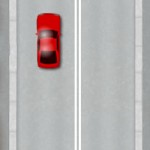
Overtaking on double white lines
Double white lines may be continuous or broken. Although exceptions, it is generally illegal to overtake or cross a continuous solid white line if the continuous line is on your side of the carriageway. The exception and when it becomes legal to overtake or cross a continuous white line is to turn into or out of a side road or property, avoid a stationary vehicle blocking the lane you are traveling in, or overtake a cyclist, horse or road works vehicle moving at not more than 10 mph.
The overtaking rule also applies to a continuous white line that surrounds a hatched marking area in the road or chevron road markings, bus lanes and cycle lanes.
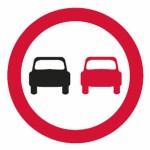
No overtaking signs
No overtaking signs are often erected in accident prone areas where high traffic flow meets hazardous roads. All circular signs edged with a red ring are regulatory signs informing motorists of an order. As with the continuous white lines, the no overtaking sign applies to other vehicles on the road and not cyclists.
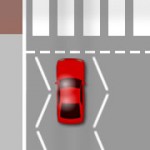
Overtaking on zig zag road markings
The white zig zag road markings are placed either side of pedestrian crossings and inform motorists that it is illegal to park, wait or overtake another vehicle within the zig zag area of pedestrian crossings.
At busy crossings, cameras are often placed to record the details of offending drivers that results in a fixed penalty. It is legal however to overtake cyclists at pedestrian crossings and within the zig zag area. See pedestrian crossings for further information.
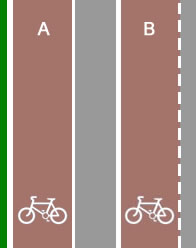
Overtaking using cycle or bus lanes
Cycle lane A has solid white line preventing vehicles from entering. Cycle lane B has broken line allowing vehicles to enter the lane if necessary. Bus and cycle lanes are edged with either broken or continuous white lines. You must not enter a cycle lane edged with a continuous white line or a bus lane during its hours of operation.
Enforcement cameras are often in place, especially at bus lanes in busy areas as a means to deter motorists to enter during restricted hours. For further information, see: bus lane signs and bus stops and bus lane road markings
Overtaking on the left
Overtaking on the left, overtaking on the inside, overtaking on the nearside and undertaking are all the same. Generally overtaking on the left is associated with dual carriageway or motorway driving. As a driving offence in itself, overtaking on the left is not illegal in the UK. The circumstances and the drivers actions can however result in driving penalties, fines or court convictions such as careless driving or the more serious offence of dangerous driving.
Overtaking on the left is legally acceptable if driving on a multi-lane carriageway in congested conditions, the lane to the left is moving at a faster speed than lanes to the right. In these circumstances overtaking on the left is permissible although extra caution is needed for an awareness of other vehicles moving to the faster lane on the left.
It is also permissible to overtake on the left if the vehicle in front is signalling to turn right. Overtaking on the left in these circumstances although permissible is subject to road markings and signs that may suggest otherwise.
Overtaking at a junction
Solid continuous white lines are often placed close to junctions to prevent drivers from overtaking at a junction. On certain roads, especially rural roads, such road markings may be non-existent. Overtaking at a junction is dangerous due to the lack of visibility for cars exiting the junction.
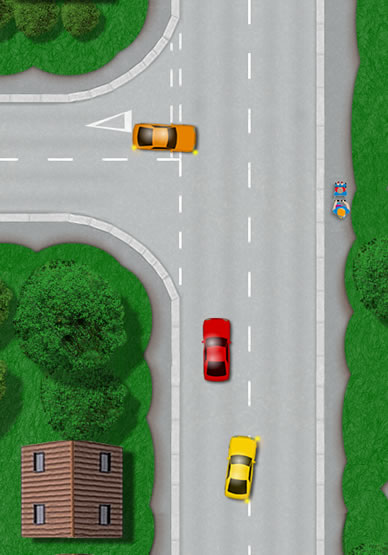
Overtaking near a junction to the left
The orange car is emerging from the junction on the left into the main road whilst the yellow car is attempting to overtake the red car.
The red car is obscuring the view of the road ahead. The driver of the yellow car will be unable to see the orange car emerging from the junction until it has entered the main road and the lane which the yellow car is using to overtake.
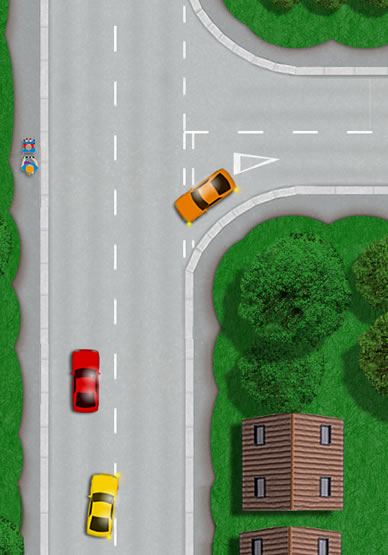
Overtaking close to a junction on the right
The orange car is emerging left from the junction up ahead on the right whilst the yellow car is attempting to overtake the red car.
Drivers emerging left from junctions often focus their observation primarily to the right, as this is the direction the traffic will be coming if they need to give way. The orange car driver could easily exit the junction and not notice the yellow car overtaking until it’s too late.
Overtaking and the driving test
The practical driving test may or may not involve overtaking. The possible overtaking scenarios may include:
-
Overtaking another vehicle
Driving examiners do like to test a learner drivers ability for overtaking another vehicle. If this is required during your driving test, it will only expected on a dual carriageway as this manoeuvre conducted on a single carriageway is far too dangerous. You will only be expected to overtake another vehicle on a dual carriageway however if the vehicle in front is traveling a sufficiently slower speed to impede your progress and if you have sufficient time and distance to safely take the exit that the examiner has explained. It also depends on whether dual carriageways are a part of the driving test routes in your area.
Another situation where you will be expected to overtake another vehicle during the driving test is if you are behind a very slow moving vehicle where it significantly impedes your progress, and then only if it is safe and legal to do so. Other forms of overtaking during the driving test is likely to be cyclists.
-
Overtaking cyclists
Driving inappropriately around cyclists fails a great deal of driving tests. Learner drivers often feel as though they must get passed cyclists as quickly as possible else the examiner will become impatient. On the contrary, you should be patient and time your passing of a cyclist carefully as the examiner would expect. There may be vehicles behind you making you causing you concern that you are slowing them down and making them impatient. Again, the priority is the cyclists safety and the examiner couldn’t care less about drivers behind, providing you are following correct procedures.
You should leave around a 1 metre gap from your car and the cyclist whilst passing to allow for unpredictable movements of the cyclist. The movements can be a factor of potholes in the road, wind or simply that the cyclists is a little wobbly. If this distance is not available, simply wait until it is. See cyclists and cycle lanes for further information on safely dealing with cyclists during a driving test.
-
Overtaking parked cars
It’s not really overtaking parked cars as such, but passing them. Examiners take you to the small and narrow streets of residential areas for various reasons, one of them being to see how you deal with passing parked cars.
Overtaking parked cars requires a good level of anticipation and planning. To anticipate a vehicle approaching and plan what action should be taken – normally by finding a space between the parked cars. Read the passing parked cars tutorial for an in-depth guide on overtaking parked cars in a variety of scenarios.
-
Overtaking on a one-way street
Providing road markings or signs do not restrict overtaking, you are legally permitted to overtake on a one-way street from any lane. As the street is one-way, you will not have to deal with oncoming traffic, but you must ensure you follow the mirror, signal, manoeuvre (MSM) routine correctly to ensure that other cars acknowledge your intention.
-
Overtaking buses
Depending on the location of your driving test, you may find yourself getting held up behind a bus whilst they stop at a bus stop. When driving behind a bus, try to look out for bus stops ahead to give you advance warning of the bus stopping and whether the bus stop has its own lay-by or whether the bus will be stopping in the road.
If the bus stop is on the main road, position yourself to the left of the centre of the road enabling you to see passed the bus when it stops. You can now assess the road ahead to establish if it is clear to overtake the bus.
Be cautious of buses. They can often pull away quickly soon after they have signaled their intention to do so. If the bus signals to move off, stay behind the bus and give the bus priority. Only ever overtake the bus if you have enough room to move back over into lane and not so that you remain alongside the bus. It’s not generally necessary to indicate to the right when waiting behind a bus as it’s usually clear to other road users that you are waiting for the bus to move off or overtake it.
If in a moving queue of traffic overtaking a stationary bus at its bus stop positioned on the main road, if it is safe to, stop and let the buss move off. Bus drivers always signal their intention to pull over or move off.

On overtaking with a junction to the right, could you elaborate on the right of way of the orange car particularly if it is a Give Way and not a Stop ? I do agree the the orange car would concentrate on traffic from the right and may not expect a car to the left which would technically be on the orange car’s side of the road/direction of travel. What if the yellow car chose to overtake a slow line of traffic so it could enter the same junction as the orange car rather than wait for its position on the road to come next to the junction ?
Hi Miriam,
Before emerging from a junction, a driver must give way to traffic that’s on the main road (the yellow car), so the yellow car would have right of way even though its overtaking manoeuvre is dangerous. Same would apply with a slow moving line of traffic, though the driver of the orange car would perhaps have more of a visible hazard to be aware of.
Can you go over the speed limit to overtake a cyclist
Hello Bob,
The only drivers that are permitted to speed are those of emergency service vehicles. Anybody else if going to court may receive a lenient outcome due to ‘special reasons’ which would have to be determined at the hearing. Simply overtaking a cyclist wouldn’t constitute special reasons.
I was overtaking a stationary bus today on a main road with houses to the left I continued to pass the bus at slow speed as I could see straight ahead at traffic but a car came out of a driveway directly in front of the bus and came straight in front of my car who does it seem is at fault here she could not see the traffic over the bus blocking her
Hi Richie,
When it comes to insurance claims, ‘fault’ isn’t always as obvious as it seems and often each party takes a certain percentage of responsibility. They would probably say something along the lines of: Both yourself and the other driver put yourselves into a situation where you couldn’t clearly see the road, but as you were already on the carriageway, the majority of blame would surely be assigned to the driver who pulled out in front of the bus.
Hi,
So I failed a recent driving test because there was a van in front of me doing a 50 on a 70mph road (dual carriageway). I was struggling to maintain the 2 second gap and also getting up to the speed limit since the van was too slow, and I was unsure as to whether to overtake as I’ve heard it generally adviced to not overtake on a driving test or else you could get stuck in that lane and if you stay too long in the right lane you can be marked down. What should I have done in this situation? Should I have overtaken or stayed behind the van (hence going slowly and not doing the speed limit)?
Hi Immanuel,
The advice you received is unfortunately incorrect. During a driving test, in a situation such as the one you encountered, you should always overtake provided that it’s safe and legal to do so. In terms of overtaking, check your mirrors and blind spot, signal and knock it down a gear or two. Accelerate at a reasonable rate and you would have got passed the van in no time. If it looks like you can do that without problems, go for it. If the dual carriageway is really busy and it looks like you might get stuck in the right lane, stay behind the van. Always avoid getting yourself into a problem situation, but if an overtake looks safe and easy, definitely go for it. The examiner will certainly want to see you overtake.